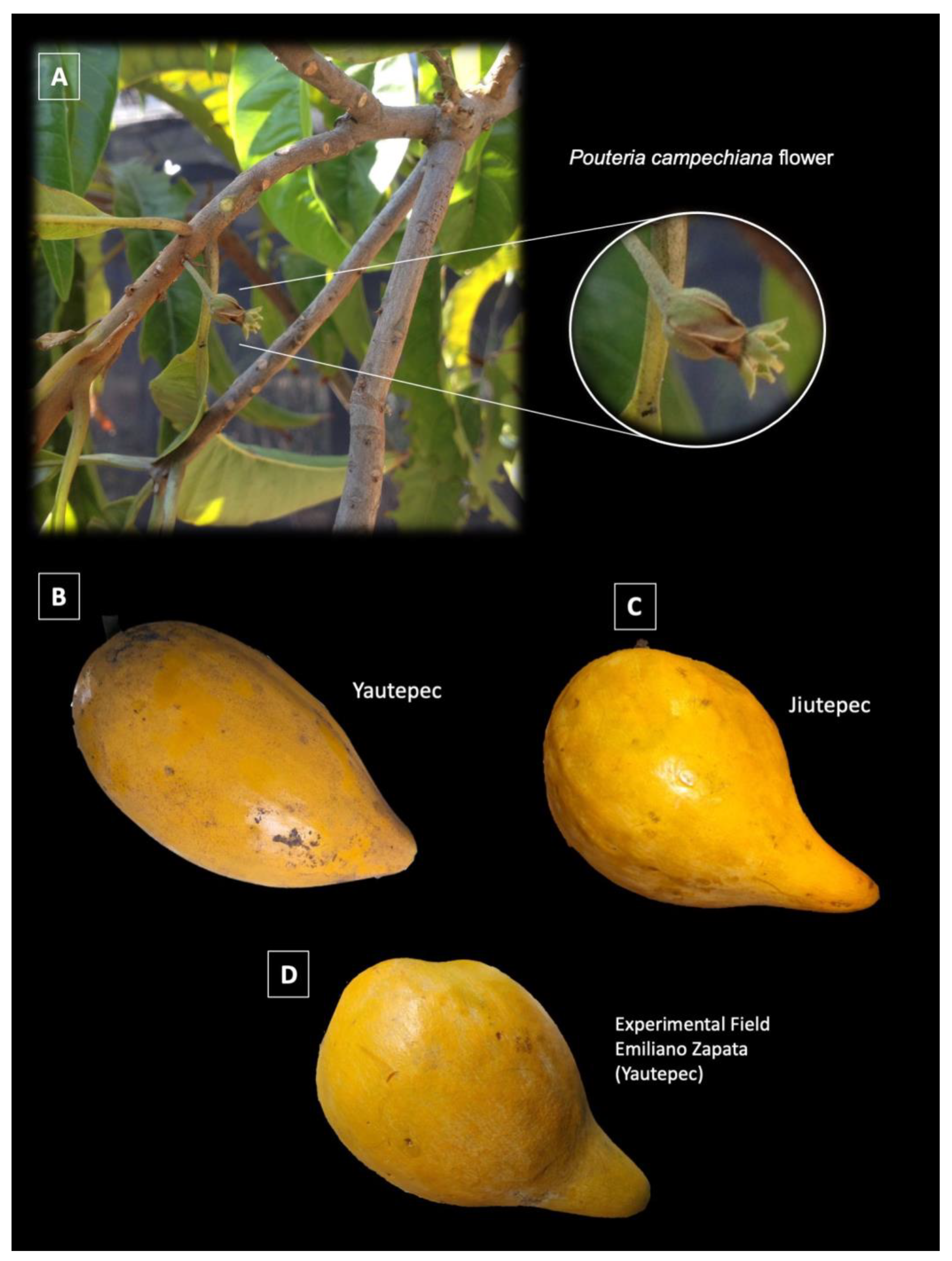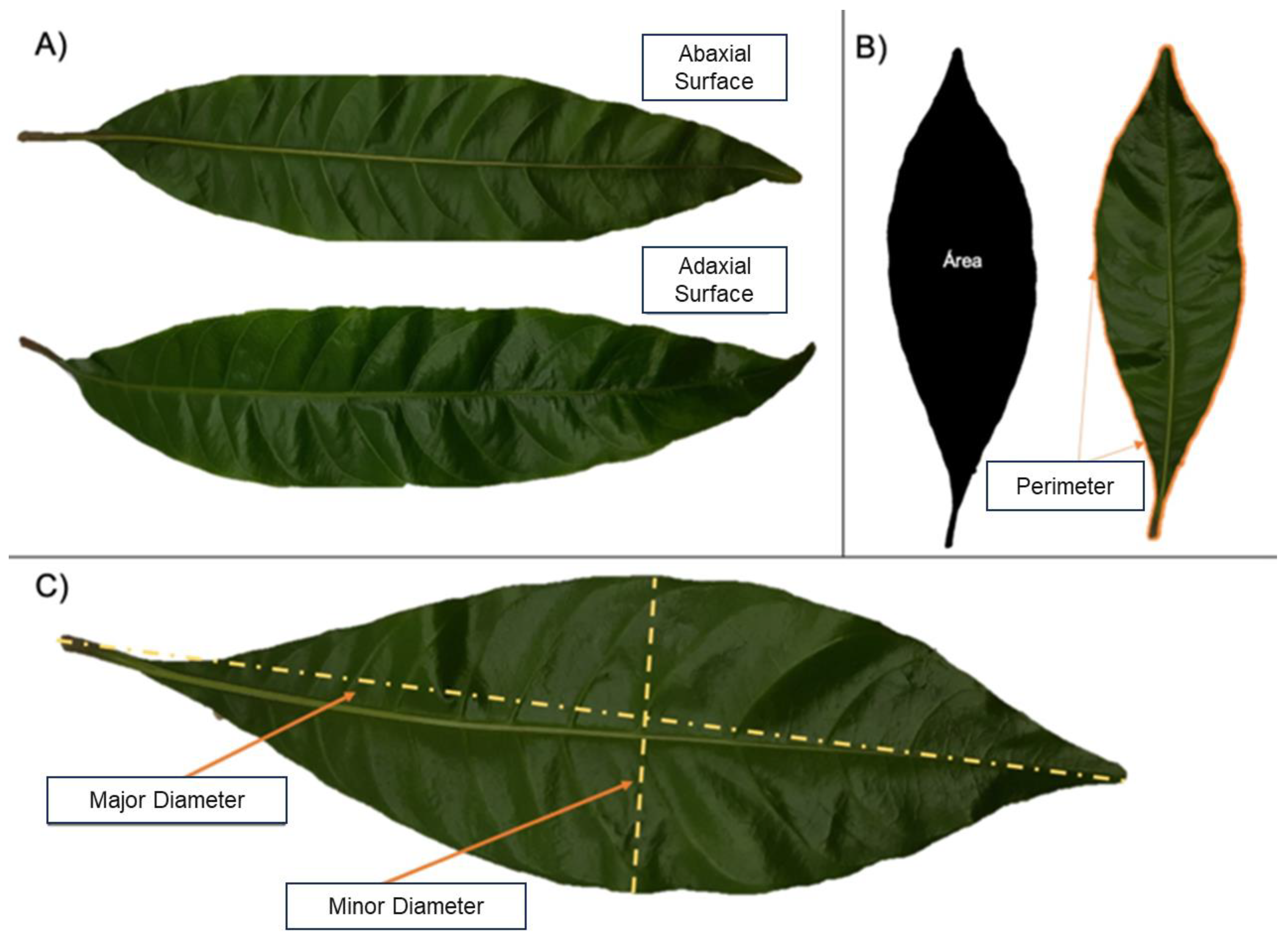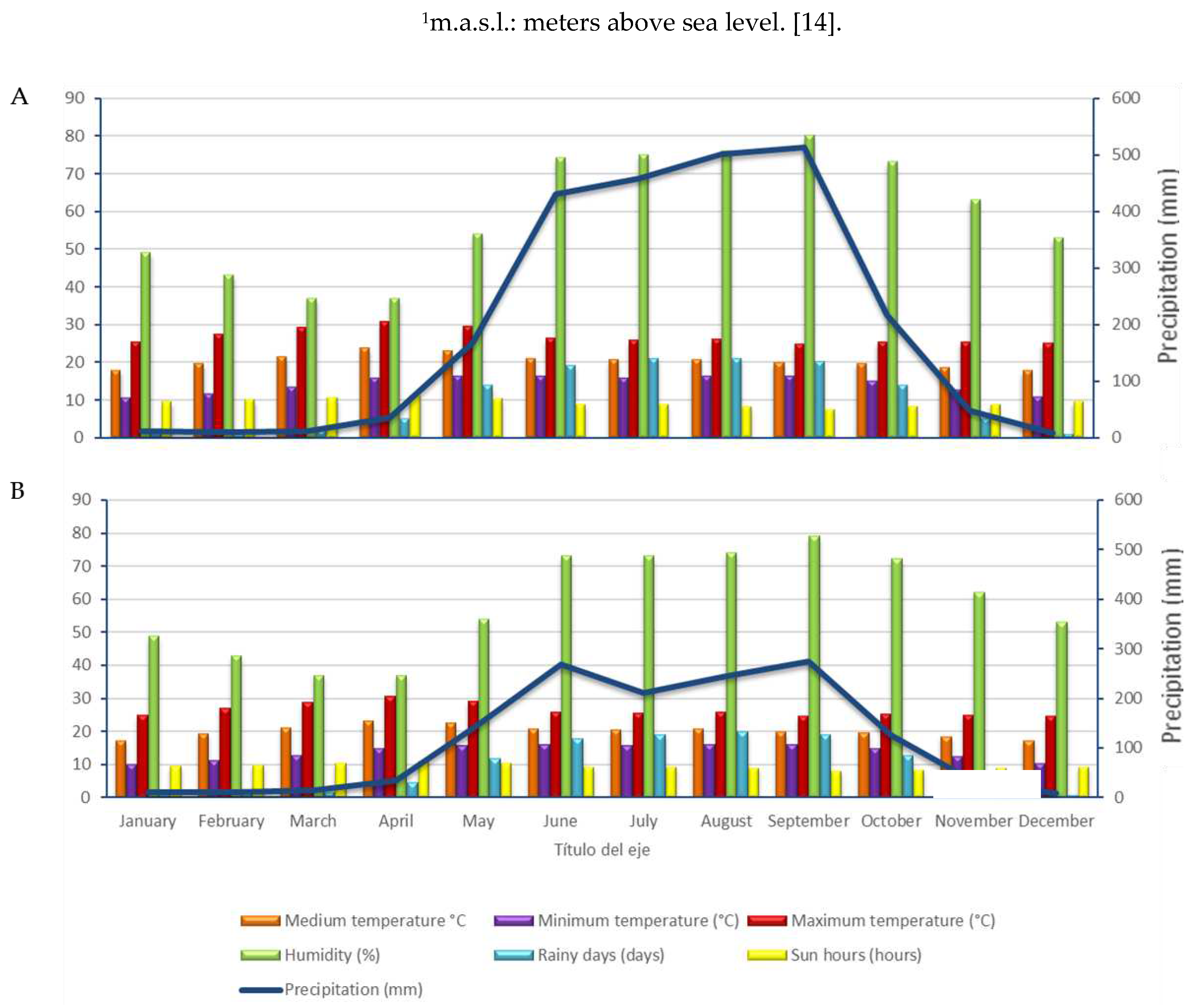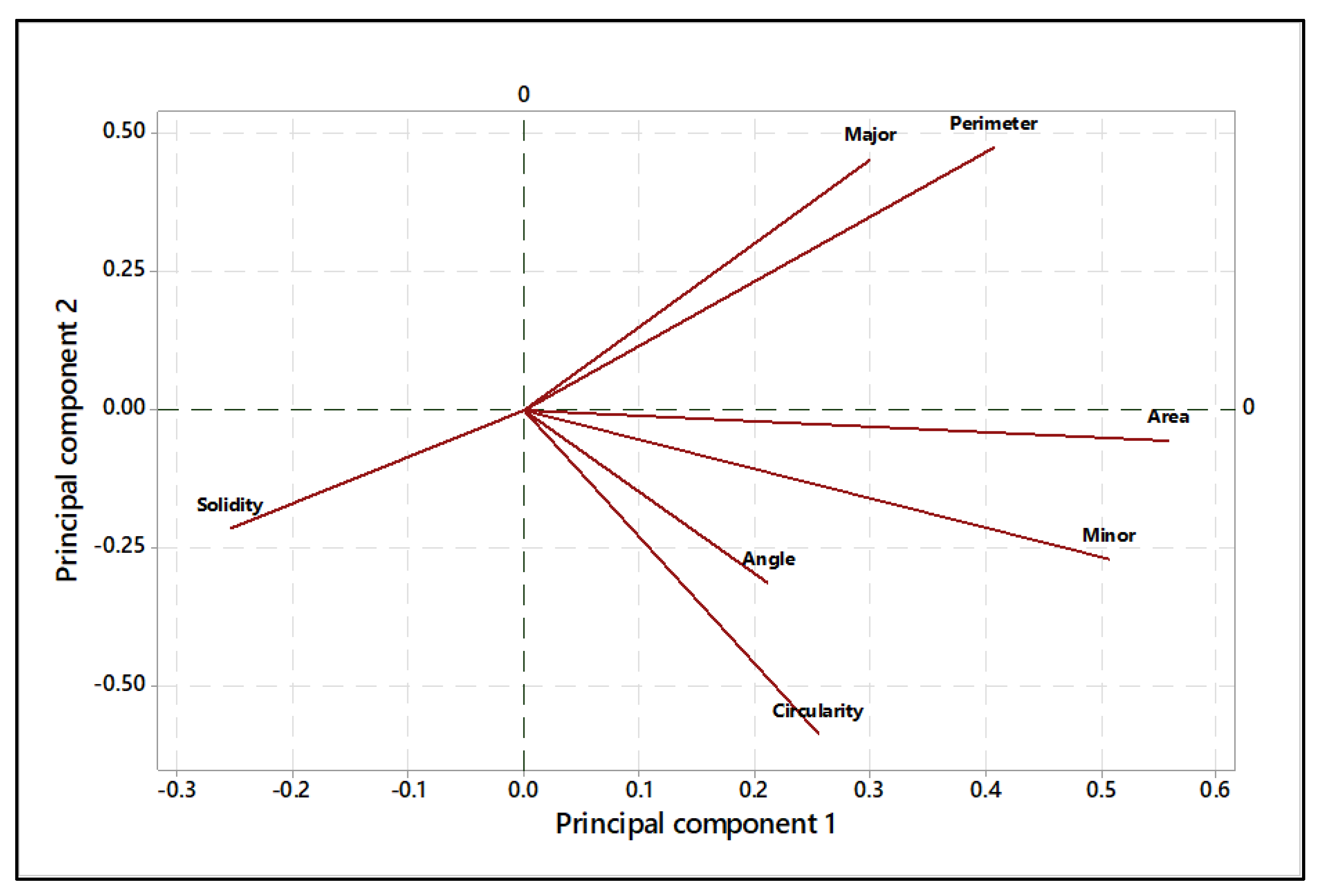Submitted:
27 September 2023
Posted:
27 September 2023
You are already at the latest version
Abstract
Keywords:
1. Introduction
2. Materials and Methods
2.1. Study zones
2.2. Planting material: growing conditions and selection
2.3. Fruit characterization
2.4. Morphological leaf characterization
- -
- Area: The number of pixels within a shape bounded by a perimeter, also called leaf area.
- -
- Perimeter: The number of pixels at the boundary of the object, in this case the leaf.
- -
- Major diameter: corresponds to the length of the leaf.
- -
- Minor diameter: is the width of the leaf.
- -
- Circularity: It is a measure of the ratio of the area and perimeter, which excludes local irregularities this value is equal to 1 for a circular object and less than 1 for an object that departs from circularity.
- -
- Solidity: It is the density of pixels, it indicates how many pixels are joined without leaving blank spaces, an object with higher solidity has no blank spaces, and an object with low solidity has blank spaces, like gaps.
- -
- The angle of the leaves was evaluated by manually segmenting and marking the main and secondary veins of each leaf on the abaxial face as follows: Freehand line> Draw> Measure.
2.5. Statistical analysis
3. Results
3.1. Study zones
3.2. Fruit characterization

3.3. Leaf morphological characterization
3.4. Correlation analysis
3.5. Principal component analysis
4. Discussion
5. Conclusions
Author Contributions
Funding
Data Availability Statement
Acknowledgments
Conflicts of Interest
References
- Pennington T. D. Sapotaceae. Flora Neotropica; Monograph 52. The New York Botanical Garden Press New York. 1990; ISBN 978-0893273446.
- Aseervatham, S. B.; Manthra, V.; Ireen, S.; Thilagameena, S. ‘Free radical scavenging potential and antihaemolytic activity of methanolic extract of Pouteria campechiana (Kunth) Baehni. and Tricosanthes tricuspidata Linn’, Biocatalysis and Agricultural Biotechnology. 2019, 18(January). [CrossRef]
- Kahkeshani, N.; Farzaei, F.; Fotouhi, M.; Alavi, S.S.; Bahramsoltani, R.; Naseri, R.; Momtaz, S.; Abbasabadi, Z.; Rahimi, R.; Farzaei, M.H.; Bishayee, A. Pharmacological effects of gallic acid in health and diseases: A mechanistic review. Iran J Basic Med Sci. 2019, Mar; 22(3):225-237. [CrossRef]
- Fitriansyah, S.N.; Fidrianny, I.; Hartati, R. Pharmacological Activities and Phytochemical Compounds: Overview of Pouteria Genus. Pharmacogn. J. 2021, 13, 577–584. [CrossRef]
- Moreira Brito, J.C.; Lima, W. G.; da Cruz Nizer, W.S. Quercetin as a potential nutraceutic against coronavirus disease 2019 (COVID-19). Ars Pharmaceutica. 2021, 62(1), 85-89. Epub 29 de marzo de 2021. [CrossRef]
- Ma, J.; Yang, H.; Basile, M.J.; Kennelly, E.J. Analysis of Polyphenolic Antioxidants from the Fruits of Three Pouteria Species by Selected Ion Monitoring Liquid Chromatography-Mass Spectrometry. J. Agric. Food Chem. 2004, 52, 5873–5878. [CrossRef]
- Kong, K.W.; Khoo, H.E.; Prasad, N.K.; Chew, L.Y.; Amin, I. Total Phenolics and Antioxidant Activities of Pouteria Campechiana Fruit Parts. Sains Malaysiana 2013, 42, 123–127. ISSN: 0126-6039.
- Manach, C.; Scalbert, A.; Morand, C.; Rémésy, C.; Jiménez, L. Polyphenols: Food Sources and Bioavailability. Am. J. Clin. Nutr. 2004, 79, 727–747. [CrossRef]
- Evangelista-Lozano S, K. M Granados-Vega, A. T. Pérez-Cortes, S.L., S. L. Escobar-Arellano, A. Rodríguez-López; J. F. Pérez-Barcena. Características de fruto de selecciones de canistel del estado de Morelos. Acta Fitogenética. 2021, 7:73, ISSN 2395-8502.
- Evangelista-Lozano, S.; Robles-Jímarez, H.R.; Pérez-Barcena, J.F.; Agama-Acevedo, E.; Briones-Martínez, R.; Cruz-Castillo, J.G. Fruit Characterization of Pouteria Campechiana ([Kunth] Baehni) in Three Different Stages of Maturity. Fruits 2021, 76, 116–122. [CrossRef]
- FAO, Food and Agriculture Organization (1993) Manual de capacitación: Prevención de pérdidas de alimentos postcosecha: frutas, hortalizas, raíces y tubérculos. In: Barden, J; Wills, R.B.H; Toet, A.; Shepherd, A. eds. Manual de capacitación. Italia, Roma: Colección FAO, Capacitación 17/2.Available online: http://www.fao.org/3/t0073s/T0073S00.htm#Contents (noviembre 2022).
- Domene, M.; Rodríguez, M. Parámetros de calidad interna en hortalizas y frutas en la industria agroalimentaria [en línea]: 1(5), pp. 1-18, 2014.]. Available online: http://www.fundacioncajamar.es/pdf/bd/comun/transferencia/005-calidadinterna-1410512030.pdf ISSN 10512030 (11 de marzo del 20122).
- Kim, H. Y. Analysis of variance (ANOVA) comparing means of more than two groups. Restorative dentistry & endodontics, 2014, 39(1), 74-77. [CrossRef]
- .
- Pennington, T.D.; Sarukhán, J. Árboles tropicales de México. Manual para la identificación de las principales especies. 2016, México, CDMX: Dirección General de Publicaciones y Fomento Editorial, Universidad Autónoma de México. pp. 438. ISBN: 9789703216437.
- Dussi, M.C. Intercepción y distribución lumínica en agroecosistemas frutícolas. In: Sozzi, G.O. (ed) 2007. Arboles frutales: ecofisiología, cultivo y aprovechamiento. Buenos Aires: Universidad de Buenos Aires. Pp 200-241.
- Available online: https://es.climate-data.org/america-del-norte/mexico/morelos-28/ (Mayo 2023).
- Atapattu, N. S. B. M.; Sanjeewani, K. G. S.; Senaratna, D. Effects of dietary canistel (Pouteria campechiana) fruit meal on growth performance and carcass parameters of broiler chicken. Tropical Agricultural Research and Extension. 2014, 16(2), 34-39. ISSN: 1391-3646.
- Domene, M.; Rodríguez, M. Parámetros de calidad interna en hortalizas y frutas en la industria agroalimentaria [en línea]: 1(5), pp. 1-18, 2014. [Fecha de consulta: 11 de marzo del 2012]. Disponible en: http://www.fundacioncajamar.es/pdf/bd/comun/transferencia/005-calidadinterna-1410512030.pdf ISSN 10512030.
- Baskin, C.C.; Baskin, J.M. Chapter 1-Introduction. En: Baskin CC, Baskin JM. eds. Seeds. Academic Press: Cambridge, Massachusetts, 2014. pp. 1-3. ISBN: 978-0-12-416677-6. [CrossRef]
- Fenner, M.; Thompson, K. The ecology of seeds, Cambridge university press, 2005; pp.
- Park, K.; Lee, H.; Jang, B.-K.; Cho, J.S. Dormancy Characteristics of Euphorbia maculata L. Seeds and Strategies for Their Effective Germination. Horticulturae, 2023, 9, 990. [CrossRef]
- Penfild, S.; MacGregor, D. R. Effects of environmental variation during seed production on seed dormancy and germination. J. of Experimental Botany. 2016, 68(4): 819-825.
- Borisjuk, L.; Weber, H.; Panitz, R.; Manteuffel, R.; Wobus, U. Embryogenesis of Vicia Faba L.: Histodifferentiation in Relation to Starch and Storage Protein Synthesis. J. Plant Physiol. 1995, 147, 203–218. [CrossRef]
- Farnsworth, E.The ecology and physiology of viviparous and recalcitrant seeds. Annual Reviews. 2000, 31:107-138 https://www.jstor.org/stable/pdf/221727.pdf (Marzo 2023).
- Colunga-GarciaMarin P.; D. Zizumbo-Villarreal. Domestication of plants in maya lowlands, Economic Botany, 2004, 58(Supplement) pp. SI01-S110. by The New York Botanical Garden Press, Bronx, NY 10458-5126 U.S.A.
- Atkin, O. K.; Loveys, B. R.; Atkinson, L. J.; Pons, T. L. Phenotypic plasticity and growth temperature: understanding interspecific variability. J. of Botany. 2006, 57, 267-281. [CrossRef]



| Study Zones | |||
|---|---|---|---|
| Descriptive characteristics |
Zone 1 | Zone 2 | Zone 3 |
| Geo location | 18.87595 LN-99.077464 LW | 18.884546 LN-99.17745 LW | 18.824988 LN-99.096042 LW |
| Locality | Yautepec de Zaragoza | Jiutepec | Yautepec de Zaragoza |
| Neighborhood | Otilio Montaño | Centro de Jiutepec | San Isidro |
| m.a.s.l.1 | 1210 | 1350 | 1059 |
| Weather | Semi-humid sub-humid (66% of the year), the warmest of the temperate climates. Warm subhumid (34%), with summer rains, the driest of the subhumid climates, low oscillation. |
Semi-warm and sub-humid (28 %), the coolest of the warm ones. Warm sub-humid with summer rainfall (72 %), the highest percentage of the year. |
Warm sub-humid (100%), dry (low deciduous forest). |
| Precipitation | Summer, the intermediate of the sub-humid (rainfall concentrated in summer). Months without rain from November to April | The average annual rainfall is 1,021 mm and the rainy season is from June to October, with 890 mm. | Summer rainfall. Percentage of winter rainfall less than five. |
| Temperature | Hot summer (34 °C ± 4), extreme (at night temperature drops 18 °C ± 3); Ganges-type temperature march (with the highest temperature in May, before rainning and the summer solstice; Ganges-type, due to the similarity of the climate in the Ganges River delta region in India. | Isothermal (the average thermal variation of the year does not exceed 3 °C), Ganges type temperature march. During the year it varies from 11°C to 32°C. The average 21.2°C; the maximum average variation is 31.4°C. The absolute maximum is 39.8 °C. The hottest months are April and May, and the coldest months are December and January. |
Extreme hot summer, hot day (35 °C ± 3) in the evening temperature drops (20 °C ± 3); the rest of the year behaves similarly. |
| Harvest season (Months) | November- December | May- July | March- April |
| Early seed germination (%) |
0.2 | 30 | 0.1 |
| Parameters | Zone 1 | Zone 2 | Zone 3 | |||
|---|---|---|---|---|---|---|
| Mean | Standard deviation | Mean | Standard deviation |
Mean | Standard deviation |
|
| Fruit weight (g) | 146.24b | 25.11 | 261.94a | 76.78 | 160.18b | 51.64 |
| Fruit polar diameter (cm) | 9.49b | 1.16 | 11.03a | 0.84 | 9.07b | 0.97 |
| Fruit equatorial diameter (cm) | 5.49b | 0.46 | 7.29a | 0.96 | 6.03b | 0.93 |
| Pulp diameter (g) | 122.76b | 27.62 | 198.88a | 54.39 | 101.26b | 35.87 |
| Number of seeds | 1.12b | 0.33 | 2.59a | 0.87 | 1.29b | 0.47 |
| Seed weight (g) | 10.12b | 2.26 | 19.71a | 5.68 | 19.78a | 3.29 |
| Seed polar diameter (cm) | 4.29a | 0.45 | 4.49a | 0.26 | 5.50b | 0.57 |
| Seed equatorial diameter (cm) | 2.08a | 0.28 | 2.24a, b | 0.17 | 2.40b | 0.22 |
| Total soluble solids (SST) | 27.47b | 2.79 | 33.18a | 0.39 | 26.12b | 1.22 |
| Parameters | LEAVES | ||
|---|---|---|---|
| Zone 1 | Zone 2 | Zone 3 | |
| Mean | Mean | Mean | |
| Area | 52.52b | 48.95a | 63.54c |
| Perimeter | 44.79b | 46.73a | 48.46c |
| Major diameter | 16.14b | 16.52a | 15.99b |
| Minor diameter | 4.10b | 3.77a | 5.07c |
| Circularity | 0.33b | 0.28a | 0.34c |
| Solidity | 0.92a | 0.92a | 0.90b |
| Angle | 48.46a | 45.42a | 56.67b |
| Area | Perimeter | Major diameter |
Minor diameter |
Circularity | Solidity | |
|---|---|---|---|---|---|---|
| Perimeter | 0.643 0.000** |
|||||
| Major diameter | 0.515 0.000** |
0.760 0.000** |
||||
| Minor diameter | 0.911 0.000** |
0.399 0.000** |
0.120 0.017* |
|||
| Circularity | 0.552 0.000** |
-0.279 0.000** |
-0.171 0.001** |
0.700 0.000** |
||
| Solidity | -0.291 0.000** |
-0.466 0.000** |
-0.076 0.129 NS |
-0.324 0.000** |
0.162 0.001** |
|
| Angle | 0.277 0.000 NS |
0.018 0.724** |
-0.070 0.163** |
0.356 0.000 NS | 0.331 0.000 NS |
-0.124 0.013 NS |
| Principal component |
Eigenvalue | Variance (%) | Cumulative Variance (%) |
| 1 | 3.0615 | 43.7 | 43.7 |
| 2 | 1.9676 | 28.1 | 71.8 |
| 3 | 1.0175 | 14.5 | 86.4 |
| 4 | 0.7358 | 10.5 | 96.9 |
| 5 | 0.2118 | 3 | 99.9 |
| 6 | 0.0045 | 0.1 | 100 |
| 7 | 0.0013 | 0 | 100 |
| Variable | Principal Components | ||
| 1 | 2 | 3 | |
| Area | 0.559 | -0.056 | -0.174 |
| Perimeter | 0.408 | 0.476 | 0.006 |
| Major Diameter | 0.300 | 0.454 | -0.434 |
| Minor Diameter | 0.507 | -0.270 | 0.029 |
| Circularity | 0.256 | -0.588 | -0.243 |
| Solidity | -0.254 | -0.216 | -0.765 |
| Angle | 0.212 | -0.313 | 0.370 |
Disclaimer/Publisher’s Note: The statements, opinions and data contained in all publications are solely those of the individual author(s) and contributor(s) and not of MDPI and/or the editor(s). MDPI and/or the editor(s) disclaim responsibility for any injury to people or property resulting from any ideas, methods, instructions, or products referred to in the content. |
© 2023 by the authors. Licensee MDPI, Basel, Switzerland. This article is an open access article distributed under the terms and conditions of the Creative Commons Attribution (CC BY) license (http://creativecommons.org/licenses/by/4.0/).





